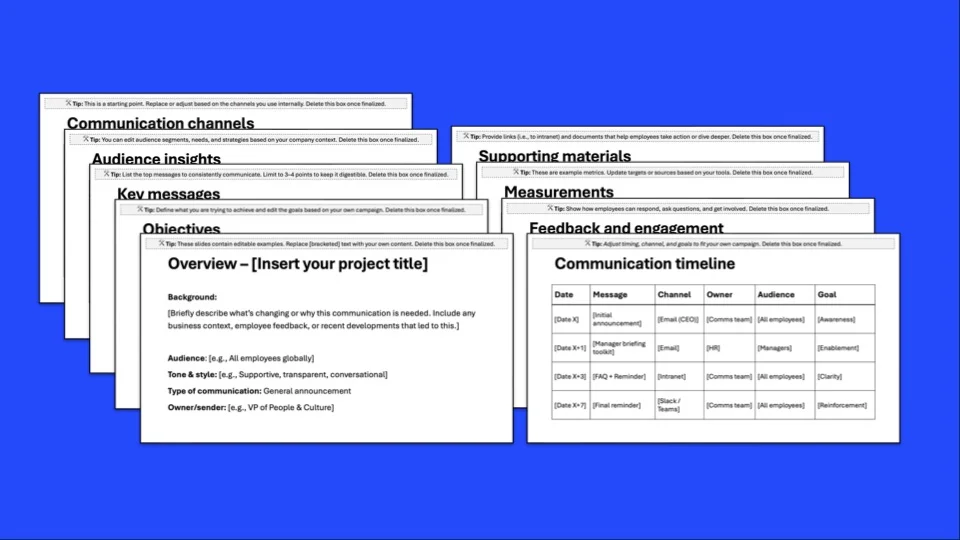Employee engagement thrives on clear, transparent internal communication. When employees feel disconnected from leadership and out of the loop, disengagement increases, leading to lower morale and productivity.
Here’s how poor communication impacts organizations.
The high cost of employee disengagement(and how internal communications help)
Employee disengagement doesn’t happen in isolation. One of the primary drivers is poor internal communication. When employees feel disconnected from leadership and out of the loop, engagement plummets. Here’s how it impacts organizations:
- Reduced productivity: Poor communication can lead to a 40% drop in productivity.
- Increased turnover: 34% of workers reported that poor communication lowered their job satisfaction, with 22% actively seeking new employment as a result.
- Low morale: 52% of employees identified increased stress as a significant consequence of poor communication.
The link between internal communication and employee engagement
Strong internal communication isn’t just about keeping employees informed—it’s about creating a workplace where employees feel valued, heard, and motivated. When companies prioritize transparent and timely communication, engagement rises, collaboration improves, and turnover decreases. For example, when employees are kept in the loop, they are more likely to feel connected to the company’s goals. When employees are well-informed and feel heard, they’re more likely to be engaged. Similarly, research indicates that companies with robust internal communication strategies are 3.5 times more likely to outperform their peers.
Step-by-step guide to to revamping your internal communications
1. Assess current communication channels
Audit existing tools: Evaluate the effectiveness of emails, intranets, and messaging apps.
Gather employee feedback: Use surveys and focus groups to understand communication pain points.
2. Promote leadership transparency
Regular updates: Encourage leaders to share company news and updates frequently.
Open forums: Host Q&A sessions where employees can voice concerns and ask questions.
3. Encourage two-way communication
Feedback mechanisms: Implement anonymous suggestion boxes or digital platforms for feedback.
Active listening: Train managers to listen actively and act on employee feedback.
4. Recognize and celebrate achievements
Public acknowledgment: Highlight employee accomplishments in newsletters or meetings.
Reward systems: Implement programs that reward outstanding performance.
5. Tailor communication to diverse teams
Multichannel approach: Use various platforms to reach all employees, from desk workers to remote staff.
Inclusive content: Make sure messages are accessible and relevant to all team members.
Pro tip: Use employee engagement surveys, like those offered by Microsoft Viva Glint and Qualtrics, to measure the effectiveness of your communication strategies. While these tools assess overall engagement, they often highlight areas where internal communication can improve 🚀
Real-life examples of how internal communications affect employee engagement
Success Story – Kmart 💡
Challenge: Kmart couldn’t achieve cultural consistency and engagement across its geographically diverse workforce. Therefore, the disconnect between the company’s cultural vision and its implementation led to varying levels of engagement and communication breakdowns. Kmart recognized that engaged employees contribute to stronger customer service and overall business success.
Approach: Kmart implemented structured engagement initiatives, including CEO forums, leadership broadcasts, and regular email updates to improve transparency. Moreover, leaders engaged directly with employees, and structured feedback mechanisms allowed staff to share concerns and ideas. Additionally, engagement goals were introduced for senior leaders to foster accountability1.
Outcome: Half of Kmart stores reported significant improvements in employee engagement, with employees feeling more connected to the company’s vision. Stores with higher engagement levels saw measurable improvements in performance and customer satisfaction.

Failure story – Netflix 😫
Challenge: In 2015, Netflix introduced an unlimited parental leave policy—up to a year off during their child’s first year. This initiative aimed to attract top talent and support employees during significant life events. However, as usage increased, the company reassessed its sustainability, leading to informal changes that created confusion.
Approach: Over the years, Netflix subtly revised its parental leave guidelines. While the official policy remained unchanged, taking more than six months off was informally discouraged. Employees were left unsure about the actual duration of leave they could take without negative career implications. Internal communication around these shifts lacked clarity, leaving employees feeling anxious and uncertain about their options.
Outcome: The lack of transparent communication on policy changes lowered employee trust and morale.
Some felt pressured to shorten their leave due to unwritten expectations which increased feelings of insecurity and disengagement.

Common pitfalls to avoid
| ✘ Overloading employees: Bombarding staff with excessive information can lead to disengagement. |
| ✘ Lack of clarity: Ambiguous messages can cause confusion and frustration. |
| ✘ Ignoring feedback: Failing to act on employee input can diminish trust. |
Final thoughts
Revamping your internal communications is not just about disseminating information; it’s about building a culture of transparency, trust, and engagement. By prioritizing effective communication, you can transform disengaged employees into motivated team members, driving your organization toward success.
Next step: Explore our guide on top internal communication tools to find the best platforms for your team.↗







